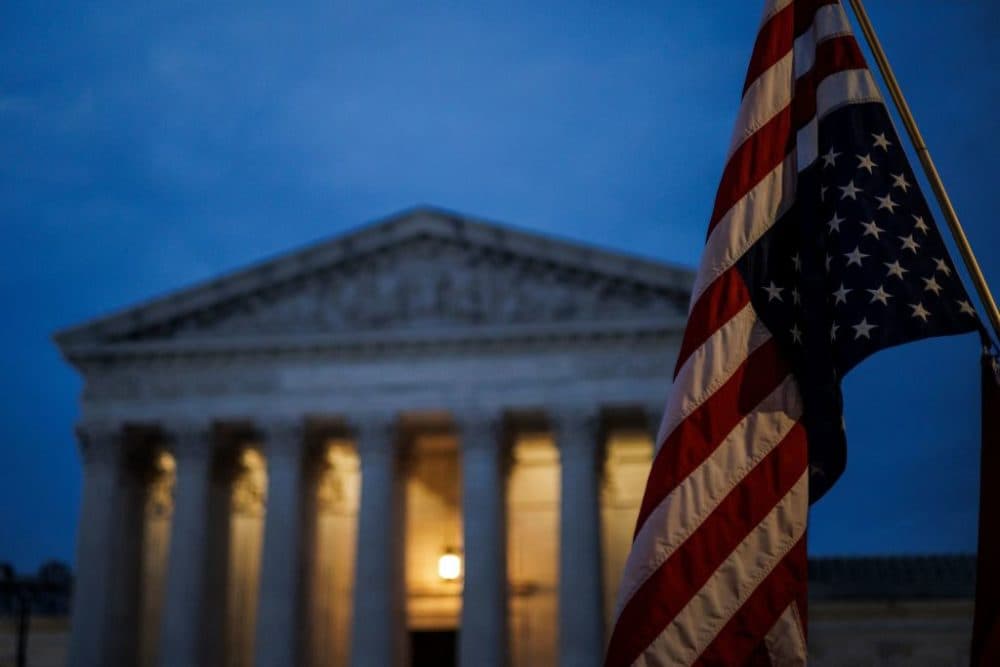Advertisement
An inside look at the Supreme Court's conservative transformation

Sign up for the On Point newsletter here.
Gallup has been polling Americans on their confidence in the Supreme Court since 1973.
The percentage of people expressing support for the court has rarely dipped below 40%.
"They have been fortunate enough to have goodwill and a lesser kind of scrutiny than the two other branches had. I think that's changing," Joan Biskupic says.
In fact, it’s changing fast. Just one in four Americans said they had confidence in the court.
Behind that, longtime Supreme Court analyst Biskupic says you can’t under-estimate the impact of Donald Trump.
"How the justices dealt with each other ... they all changed their approach in various ways because of the pressures of Donald Trump," Biskupic says. "That has really changed the law in America, which we see most evidently in the rollback of reproductive rights."
Today, On Point: The remaking of the Supreme Court.
Guest
Joan Biskupic, senior Supreme Court analyst for CNN. Her new book is called, Nine Black Robes: Inside the Supreme Court's Drive to the Right and Its Historic Consequences.
Interview Highlights
On abortion access in Texas
Joan Biskupic: "Let's just remind people what the Supreme Court itself did that opened the door to what Judge Matthew Kacsmaryk in Amarillo, Texas, did back in June. The justices rolled back nearly 50 years of constitutional abortion rights, reversing the 1973 landmark Roe v Wade. It said, importantly. First of all, that there is no longer a constitutional right for a woman to end a pregnancy. But at the same time, it stressed that it was returning the issue to the states. And key Justice Brett Kavanaugh, who was one of the five in the majority, wrote separately to say, we are not outlawing abortion nationwide.
"So since then, you have all sorts of action by anti-abortion opponents trying to push even further to restrict abortion rights. And that led us to the case in the northern district of Texas, in which a group of anti-abortion physicians and medical groups sued the Food and Drug Administration for its approval of the abortion medication drug mifepristone. ... And tried to get Judge Kacsmaryk to completely rollback that approval, which he did. They found exactly the right judge. They essentially looked specifically for a judge like Matthew Kaczmarek, a 2000 appointee of Donald Trump.
"And they got a sweeping ruling from him in which he acknowledged he was second guessing what the FDA had done in its approval that dated all the way back to 2000. So we get that ruling in early April, as you say. Then a regional appellate court, the U.S. Court of Appeals for the Fifth Circuit. Looks at Judge Cosmetics decision and says it disagrees with the lower court judge on his nullification of the 12 year 2000 approval from the board. It's correct, but it allows part of his order that would really restrict the access, access to the judge to go into effect, to the drug, to go into effect.
Advertisement
"And just so our listeners know what we're talking about. It was the order that the Fifth Circuit imposed, which is, you know, right now in play, it decreases the window of availability for the drug from ten weeks of pregnancy to just seven weeks of pregnancy. It went back to requiring three in-person visits to obtain the drug. And it also said that a loosening of access that the FDA had put into effect in recent years allowing for women to obtain the drug by mail, after consultations with medical personnel, that it couldn't be by mail, it would have to be in person."
On Donald Trump's judicial approach
Joan Biskupic: "First, just in that moment that you played, those justices were sitting in the seats there in the East Room of the White House feeling tricked. They had been persuaded to attend an event that they already had feared would be political because it was over at the White House. It was just in the wake of the contentious Brett Kavanaugh hearings, and they had resisted. And Chief Justice John Roberts had gotten some assurance from the White House Counsel's office that, no, this will be a very serious, decorous event and listen to what happened.
"So they were very angry that they had, as I said, felt, you know, really tricked into showing up. And, of course, Donald Trump turns it into an even more political event by bringing up how he has cast Brett Kavanaugh is a victim of the of the hearings, certainly. But that was what Donald Trump was all about. He had such a personalized view of the judiciary. First of all, he acted as if anyone he put on the court was his in some way his to control. He he used to say things like, you know, just wait till we get to the Supreme Court when he lost in the lower courts. And then he had that very famous clash with the chief justice when a lower court judge ruled against one of his own asylum policy of the Trump administration.
"And Trump tried to disparage the judge by referring to him as an Obama judge. And that was the only time during his whole four years that Chief Justice John Roberts was so prompted to speak out. And that's when he said in November of 2018, there are no Trump judges, there are no Obama judges, there are no Bush judges or Clinton judges. We just have judges trying to act fairly. Now, you can probably argue these days with that assertion, but it was what finally roused John Roberts to go public because he had by that point really had enough of Donald Trump and his trying to, you know, overly politicized the judiciary, at least in the public eye, having nothing to do with his appointments."
On the politicization of the court
Joan Biskupic: "There's this judicial conference. That's the policymaking arm of the federal judiciary. It's not going to do anything. In fact, the judicial conference is essentially an entity that buys into the idea of as little disclosure and explanation as possible. It's a group made up of judges. And then finally, you know, what about Congress? Now, there's really mixed sentiment occurring in Congress. You've heard from people like Senator Sheldon Whitehouse, who has been really riding the issue of judicial, judicial ethics and Supreme Court disclosures. And, you know, the Senate Judiciary Committee chairman, Dick Durbin, has adopted some of that talk.
"But I just don't see them doing anything serious in terms of, you know, trying to amend any laws or put any real pressure on the court. And I have to say there's this other issue of separation of powers. So I think it's something that makes them a little bit skittish. And frankly, right now, the Senate Judiciary Committee is more trying to get Biden judges confirmed, which is a very important priority for them, that I think this is this this issue with Clarence Thomas makes for a lot of rhetoric. But will it make for any change or any new pressure on the Supreme Court? I'm just not sure."
On conservatism and the Supreme Court
Joan Biskupic: "Religious conservatives have been faring so well at the Supreme Court, and we even had a case this week that would play into that. Just to remind everyone, remember, they cited 623 with a football coach at a public school who wanted to play, who wanted to pray at midfield, often with players around him. They said that was absolutely fine. That did not reach any kind of separation of church and state, even though the school district was like, We don't want this.
"And then they also last year ordered Maine to provide public funding to a religious school. They have a new case before them involving when workers would want to claim religious discrimination, when an employer does not accommodate their schedule. For example, it's a mail carrier who didn't want to work on Sunday. And there are all sorts of issues in terms of balancing the needs of an employer and also coworkers who would have to pick up the parts of the individual shift. But the theme among all these cases, and we have had many, has been that the religious conservative interests prevail. And I think Justice Alito is at the forefront of feeling as if religion is really under siege in America and wanting to counteract that."
Book Excerpt
Excerpted from NINE BLACK ROBES: Inside the Supreme Court’s Drive to the Right and Its Historic Consequences by Joan Biskupic, published by William Morrow. Copyright © 2023 by Joan Biskupic. Reprinted courtesy of HarperCollins Publishers.
This program aired on April 20, 2023.

